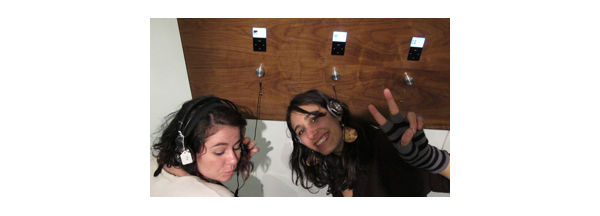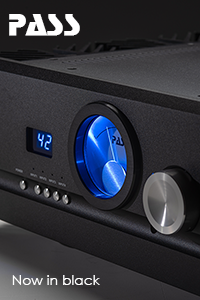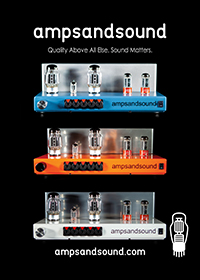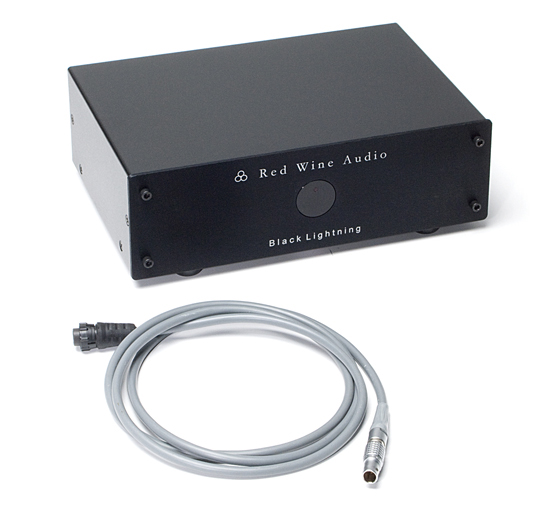 By Jeff Dorgay
By Jeff Dorgay
If you’ve been reading TONEAudio for the last couple of years, you know I’m a big fan of the battery-powered gear from Red Wine Audio, built by Vinnie Rossi and his team. I’ve used their Signature 30.2 power amplifiers and their Isabella tube preamplifier with excellent results. The key to a large part of these components success is the fact that they are powered “off-the-grid” from high-current, sealed lead-acid (SLA) batteries, and Red Wine Audio has made the them effortless to use thanks to their SMART charging system.
The great thing about SLA batteries is that they have very low impedance (very high output current capability) and relatively flat discharge characteristics. The benefit to you is that the sound does not change as the batteries begin to discharge, and dynamics are maximized. I’ve used a number of battery-powered components, and the ones that rely on normal alkaline batteries (the Sutherland PH3D and Chord preamps come to mind) change their sound dramatically over the charge period and don’t have the low output impedance. The result is a sound you can’t really get used to.
SLA batteries are much better in this application, but they do require a certain amount of care to keep them performing at their peak, but who’s got time for that? What Red Wine Audio has done with their new SMART (SLA battery Monitoring and Auto Recharge circuit) board is to make the battery process a “no fuss, no muss” affair. Everything works in the background, so you only need to concentrate on the music. When the battery voltage discharges down to a set level (which is continuously monitored via the SMART board), the SMART circuit automatically turns OFF the unit and begins the recharge process for you. In addition to being very convenient, it maximizes battery life by avoiding accidentally deep-discharging the SLA batteries.
There are three other very important features worth mentioning about the Black Lightning: First, when you are using battery operation, the charging circuit is completely disengaged from the batteries, so there is no chance of noise leaking into the power supply. The battery charger itself is a separate unit that plugs into the Black Lighting for total isolation.
Second, the Black Lightning has 0.5 second in-rush current limiting avoid the high current in-rush that you don’t typically see with conventional AC power adapters because they cannot supply nearly the same level of output current. According to Vinnie, it’s actually better to leave your component switched on all the time and use the power switch on the Black Lightning as your power switch, thus always allowing “soft starts” of your audio component – which prolongs the life of their internal components.
Third, and possibly most important, I have to believe that while a good portion of the Black Lightning’s improvement comes from removing your audio component from the grid, it also eliminates one or more switching power supplies from proximity to your system. Anything in your HiFi system that uses a “wall wart” power supply is a noise bandit, dumping a healthy amount of RFI back into your power line and associated components. Even with world-class power line conditioning, I noticed a slight decrease in background noise with my other components, having eliminated the two switching power supplies from my system.
Red Wine brings this technology to the rest of us
As cool as the idea of getting off the grid is, for most power amplifiers, it’s not practical because of the high voltage requirements. But for preamplifiers, phonostages, dacs, and other low-level components that accept DC input voltages from AC wall adapters, Black Lightning will elevate the performance of your components to a whole new level. The minute you leave the grid, you’re leaving any AC-related noise and distortion components behind completely.
Earlier this summer, Vinnie and I were discussing exactly this and I asked him if he could build an upgraded 12Vdc power supply for my Nagra VPS phono preamplifier. I’d like to think I had a small hand in the process and in November, the Black Lightning was born. There are two models to choose from, the Series 10 and the Series 12. The main differences between them are the available output voltages and their current capacity (measured in Amp-Hours), which translates into the ability to power a component that draws more current for a longer period of time.
You can read the full list of configurable options here:
http://www.redwineaudio.com/products/black-lightning
The Series 10 starts at $625 and the Series 12 starts at $825. When you think about it, that’s just about what a good power cord would set you back. Hmmm. My review centers around three components that I felt would respond very well to being removed from the grid and that accepted a 12Vdc input (which I had Red Wine Audio configure a Series 10 unit for me); the Nagra VPS phono stage, the Nagra LB portable digital recorder and the Wadia 170i iPod dock.
Across the board gains
The $9,000 Nagra VPS/VFS phono stage has been my reference for over a year now and is a hybrid tube/solid state design. I’ve been very satisfied with the VPS/VFS, but it’s always had the slightest bit of background noise and hum that I’ve just chalked up to life with tubes.
Immediately after plugging the Black Lightning in, all of the noise was gone, even when sticking my ear right up to the tweeter. The Black Lightning redefines the term “inky black background.” The big surprise was when I set the stylus down on the first record, Neil Young’s Live at Massey Hall. (200g. Classic Records version) We gave this record one of our product of the year awards in the audiophile recordings category. If you have this record, you know how big the soundstage is, but adding the Black Lightning just blew the boundaries out of my room. The Nagra’s already excellent dynamics went up a few solid notches. It just wasn’t the same preamplifier anymore. Everything I loved remained, but now it was super sized!
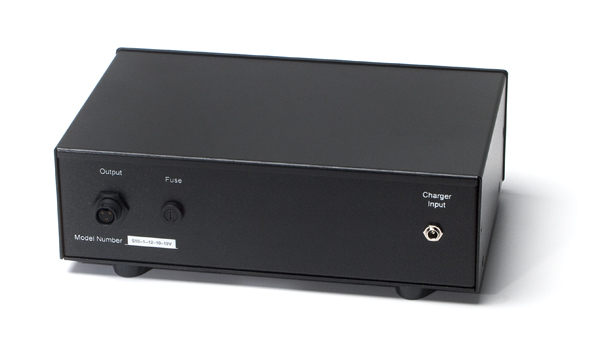 I am a big believer in clean power, and the validity of good power cords, but I’ve never had this much improvement from any power cord or line conditioner. I currently use the Running Springs Dmitri line conditioner on the front end of my system (and a Running Springs Maxim on a separate 20 amp line for my power amplifier) and I feel this product is the top of the mountain in power line conditioning products. I would compare the difference plugging the Nagra into the Black Lightning to be an equivalent jump in performance I experienced when I plugged the rest of my system into the Dmitri from the wall. Background noise decreased dramatically, dynamics increased substantially and the upper registers got smoother, yet more defined.
I am a big believer in clean power, and the validity of good power cords, but I’ve never had this much improvement from any power cord or line conditioner. I currently use the Running Springs Dmitri line conditioner on the front end of my system (and a Running Springs Maxim on a separate 20 amp line for my power amplifier) and I feel this product is the top of the mountain in power line conditioning products. I would compare the difference plugging the Nagra into the Black Lightning to be an equivalent jump in performance I experienced when I plugged the rest of my system into the Dmitri from the wall. Background noise decreased dramatically, dynamics increased substantially and the upper registers got smoother, yet more defined.
The more records I played with the new “upgraded” Nagra, the more impressed I was with the contribution of the Black Lightning supply. The effect was all positive and not the least bit negative. The bass drive had increased substantially, as if I had added a subwoofer to the system!
As much fun as the additional bass grunt was, this already detailed phono preamplifier was considerably better with microdynamics than before. No matter what kind of music I was listening to, I was always able to hear further into the recordings than I could before, thanks to the lower noise floor. This also gave my system the added benefit of sounding “louder” even at low volumes because the effective dynamic range was increased.
I’d also like to mention that when Vinnie and I were discussing playback times as he was developing the Black Lightning, I was expecting about 4 hours worth of playback time with the Nagra VPS (based on its power consumption rating) and I’m getting about 8 hours consistently. Very impressive!
Benefits with other devices as well
I had similar results with the Wadia iTransport dock, and this was very easy to discern using the Wadia 781i as my DAC. Everything was decidedly “less digital” sounding and the gap between .wav files on my iPod and the CD played on the Wadia closed further.
When using the Black Lightning with my Nagra LB digital recorder that is already battery powered by AA batteries, the main difference when using the Black Lightning SLA battery supply was slightly increased dynamics, better resolution during lower level passages and much longer record time. The LB will eat up eight AA cells in pretty short order, and with the Black Lightning I was able to record all day long without stopping to recharge. Again, the added benefit here with a Black Lightning is that you aren’t tossing a pile of Duracell’s (that contain mercury) in to the wastebasket on a regular basis. Better sound and better for the environment.
A product that truly exceeds expectations
In the world of high-end audio, there are a lot of snake oil vendors and precious little science and engineering, with every new widget promising nirvana where none previously existed. Red Wine Audio’s Black Lightning power supply is well-built, with solid engineering behind it and does a fantastic job at its designated task. You can’t ask any more from a component!
If you have something in your system that uses a switched mode/wall wart power supply and feeds a DC output voltage to your component, the sonic benefits you will receive from the Black Lightning will be instantly apparent. It has certainly made a welcome addition to my reference system. Give Vinnie a call to see if he has one that will suit your needs.
The Red Wine Audio Black Lightning, $650 – (approx.) $1,000 depending on size and configuration.
www.redwineaudio.com




 By Jeff Dorgay
By Jeff Dorgay I am a big believer in clean power, and the validity of good power cords, but I’ve never had this much improvement from any power cord or line conditioner. I currently use the Running Springs Dmitri line conditioner on the front end of my system (and a Running Springs Maxim on a separate 20 amp line for my power amplifier) and I feel this product is the top of the mountain in power line conditioning products. I would compare the difference plugging the Nagra into the Black Lightning to be an equivalent jump in performance I experienced when I plugged the rest of my system into the Dmitri from the wall. Background noise decreased dramatically, dynamics increased substantially and the upper registers got smoother, yet more defined.
I am a big believer in clean power, and the validity of good power cords, but I’ve never had this much improvement from any power cord or line conditioner. I currently use the Running Springs Dmitri line conditioner on the front end of my system (and a Running Springs Maxim on a separate 20 amp line for my power amplifier) and I feel this product is the top of the mountain in power line conditioning products. I would compare the difference plugging the Nagra into the Black Lightning to be an equivalent jump in performance I experienced when I plugged the rest of my system into the Dmitri from the wall. Background noise decreased dramatically, dynamics increased substantially and the upper registers got smoother, yet more defined.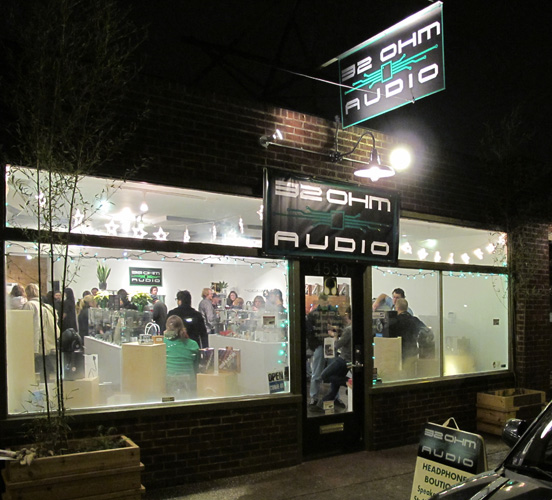 While CNN and Fox News are both presenting their own version of the economic collapse, the Christmas shopping season is alive and well here in Portland, Oregon at the world’s first exclusive headphone boutique, 32 Ohm Audio. I know nothing warms my heart like seeing people out in force, buying audio gear!
While CNN and Fox News are both presenting their own version of the economic collapse, the Christmas shopping season is alive and well here in Portland, Oregon at the world’s first exclusive headphone boutique, 32 Ohm Audio. I know nothing warms my heart like seeing people out in force, buying audio gear!
